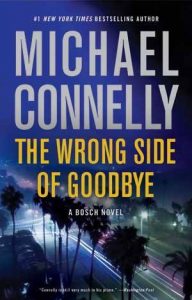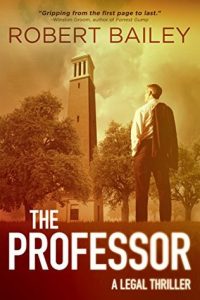Recently I read two thrillers, Robert Bailey’s The Professor and Michael Connelly’s The Wrong Side of Goodbye. When I related the plot of Connelly’s latest to my husband, he remarked, “Seems like it’s pretty much by the numbers.”
“By the numbers” alludes to the old-time hobby kits in which a painting—usually a famous one—is reduced to a schematic of numbered parts that correspond to its colors. Using paints included in the kit, the hobbyist dabs the correct color on each part to reproduce the painting in all its glory. Well, kind of. No matter how carefully the hobbyist applies the paint, the reproduction lacks the magic of the original.
“By the numbers” is a disparaging way of describing a novel that mechanically reproduces a plot line, tropes, or characters common to its genre.
The Wrong Side of Goodbye
I bristled at hearing The Wrong Side of Goodbye described as a “by the numbers” crime thriller. Okay, it’s not my favorite Harry Bosch novel. Like all of Connelly’s recent books, its sparseness leaves little room for contemplation or emotional resonance. Still, I enjoyed the story and cared what happened to the characters, who have enough complexity to be believable.
Forced into retirement from the LAPD and working as a private detective, Harry is hired by a billionaire to find the illegitimate child that the billionaire fathered with a Mexican cafeteria worker in the 1950s. The billionaire wants to leave his money to this child, his only offspring. Harry uncovers the heartbreaking and inspiring story of this woman and the son she bears. I anticipated much of the story (but not the rather neat twist at the end).
Harry Bosch—one of the great detectives of fiction
After a dozen or more books, I feel as if I know Harry, a stubborn man with a troubled past, a quick temper, and even quicker mind. He’s changed a lot since the beginning of the series. He’s much less hotheaded these days. When he receives a profanity laden email from a cop angry at him for suing the LAPD, he pounds out a sarcastic reply . . . and then deletes it.
Being a single father has also changed Harry. He’s become more patient and sensitive, as shown when he and his daughter negotiate where to meet for dinner. She wants to try a new Vietnamese restaurant. Harry’s blunt refusal offends her. Being a man who keeps his feelings under wraps, he’s not used to explaining himself. But his need for her understanding overcomes his macho reticence. He explains that he had to eat Vietnamese food every day while fighting in the Vietnam War:
“You smell like what you eat. In enclosed spaces. It comes out in your pores. My job—I had to go into tunnels, and I didn’t want the enemy to know I was there. So I ate their food every day, every meal, and I can’t do it anymore. It bring it all back to me.”
The Wrong of Goodbye isn’t “by the numbers.” It’s original Connelly.
The Professor
Thomas McMurtrie, protagonist of Robert Bailey’s legal thriller, is a former star football player and now a venerable law professor at the University of Georgia. Tom is forced into retirement thanks to the machinations of the weaselly dean and Jameson Tyler, a hotshot attorney and one of Tom’s former students, whom he had considered a friend.
An old flame comes to him for help. Her daughter, son-in-law, and granddaughter died in a collusion with a semi. The driver was speeding and the old flame wants to sue the trucking company for negligence. Tom refers her to Rick Drake, another former student. Although definitely not Tom’s friend, Drake grew up in the town where the accident occurred and the case will be tried.
Enter the villains
The case becomes thorny when Jack Willistone, the owner of the trucking company, hires Tyler to defend his company against the suit. Willistone is a small-time tycoon whose hirelings commit arson and threaten and bribe witnesses.
It’s revealing that he sends the psychopathic thug Bone to intimidate the characters who are low on the social ladder. If they talk to the lawyers, Bone threatens to rape their wives and/or daughters while they watch and other fun stuff. Willistone feels he can have them killed and get away with it. But with the wife of the gas company, he goes after her reputation. He has pictures proving that her dead husband was gay and will make certain that her teenage boys see them unless she keeps her mouth shut.
That old-time machismo
This thriller is saturated with Southern machismo. The women are so hapless. They’re not incompetent, just unable to fend for themselves. They need the men. Even Dawn the law student needs help from Tom. And there’s lots of football stuff about loyalty to teammates and friends, playing to win, and never wussing out. Not that it’s unbelievable or wrong or anything. I just got tired of it.
In addition, I couldn’t buy into the moral simplicity. It’s always clear what’s right and wrong. Wrong actions in one aspect of life indicate a moral rottenness that infects every other aspect of a character’s life. The amoral attorney Tyler dates two women at once, so of course he ambushes his old friend Tom with the charges that cost him his teaching position, and he breaks his promise not to make public the supposedly compromising photos of Tom and Dawn.
Is The Professor “by the numbers”?
The plot rolls along at a brisk pace with the familiar tropes of legal thrillers: the surprise witness, evidence that surfaces at the last minute. But the setting is vivid and the characters transcend their stereotypes. I won’t forget Tom McMurtrie and might pick up another novel in the series sometime.
All thrillers are written “by the numbers” to some extent since writers follow the rules of the genre. I suspect that the term is a way of disparaging genre fiction in general. When critics dismiss novels as “by the numbers,” it means they dislike genre fiction—and not much else.
















Leave a Reply
Want to join the discussion?Feel free to contribute!